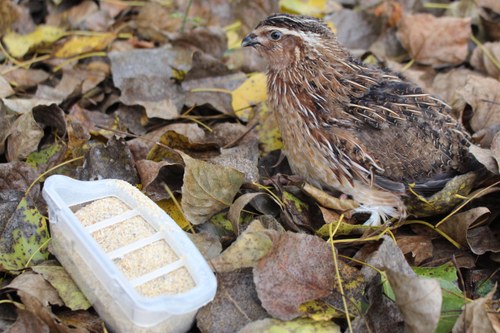
For meat production, Japanese quails are selected for rapid growth rate and for advantageous feed conversion ratio. In Europe, from the 1960’s, France was considered the most important quail-producing country, but today Italy and Spain show higher export markets. The quail chicks are purchased as day-old chicks (at hatch), reared up to the age of five weeks, then slaughtered in specialised abattoirs, and sold to the market. Chicks are very small and cannot adapt in a cold environment, thus, adequate brooding temperatures must be ensured (optimal temperature: 35 °C).
For this reason, quail chicks reared up to market age are housed in two different types of cages: brooder cages (from day-old to 17-18 days of age) and a grower cages (from 18-19 days to market age). The optimal stocking density is 25 kg/live weight/m2 in naturally ventilated houses, and 35 kg live weight/m2 in environmentally controlled houses. The slaughter yield ranges from 60 to 75 % depending on slaughter age, genetic line and sex. Regarding the commercial cuts, the prime cut is the breast, which varies from 25 % to 36 % of the carcass weight and legs which varies from 16 % to 22 % of the carcass weight.
Quail meat production is considered negligible compared to broiler chicken meat production but it contributes to the variety in poultry meat product, occupying in the recent years an increasing place in poultry livestock farming. However, track an accurate status of the Japanese quail production around the world is still difficult because quail meat production is a young productive sector compared to other poultry species, and meat is quite far from being a regularly consumed product. Nowadays, China, Europe (Spain, France, Italy) and the USA are the largest producers of meat-type quails but some initiatives to increase production have begun in India, Australia and Canada.
In the last years, the popularity of quail meat has increased among consumers, and seen as a healthy food for all ages. Quail meat is tender, tasty, and can be prepared in any of the ways used for chicken meat. It is characterized by low fat and cholesterol content compared to red meats and is considered one of the leanest types among poultry meats. Low fat and cholesterol content are due to thin skin and low fat accumulation between the tissues.
the nutrients composition of quail breast meat is reported in Table 2. In detail, the water content is around 74.5%, whereas the protein content is relatively high (23.9 %). As for the lipids content, in breast meat it is around 4.9%, however large differences could be observed according to sex and slaughter age. Furthermore, quails meat is a good source of vitamins (niacin, thiamine, vitamin B6, riboflavin, and pantothenic acid), essential amino acids (lysine, leucine, methionine and cysteine), and minerals (sodium, potassium and iron).
This meat is considered to contribute to the prevention of heart diseases because of its high amounts of PUFA. In general, a constant consumption of quails meat promotes body and brain development in children and is considered good for pregnant women.